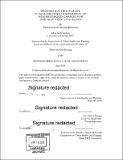Deconstructing places : a data-driven ethnography of neighborhood change for one New York city block
Author(s)
Holtzman, Elisabeth Phoebe Kamine
DownloadFull printable version (24.00Mb)
Other Contributors
Massachusetts Institute of Technology. Department of Urban Studies and Planning.
Advisor
Andrea Chegut.
Terms of use
Metadata
Show full item recordAbstract
Neighborhoods are complex and dynamic. An attempt to tease out how and why neighborhoods change requires interdisciplinary study that reflects the layers of interrelated people, places and things that make up an urban neighborhood. Urban data science aims to measure neighborhood change, yet it is challenging to quantify how a place changes over time, space and people. Moreover, these measures are important because planning and economic development policy that relies on these measures impacts future place-making and community development. To understand neighborhood change at a granular scale that can be useful to decision makers, I conduct a data-driven ethnography in which I assemble, analyze, and integrate over 45 urban planning and real estate datasets to develop quantitative metrics that measure the rate of change for the 1817 to 2017 period for Block 800 in New York City. Quantitatively, long-run metrics on rates of neighborhood change were previously unable to identify. In this way, I was able to document that change is always happening to a building, property, person or price, but its positive and or negative trends are often very slow to articulate in datasets or statistical models. The quantitative results suggest that, on average, buildings move slowly by netting 0.01 buildings per annum over the 1817 to 2017 period, properties more rapidly at 0.45 per annum and people even more rapidly at a projected rate of 1400 people per annum. In addition, not all changes are equal in speed or impact, where change can accelerate at so-called inflection points where technological progress in society is meeting the built environment and the people operating within. At these points, the speed of a neighborhood can increase rapidly causing displacement and gentrification and at other times, progress is absent with long periods of decay. Importantly, calculating rates of change could not be done without data-driven ethnographic methods that allows for integrating and not aggregating data. Integrated place data are intricately linked to retell a long, wide, and big data neighborhood story. These methods can now be replicated at a larger scale with the proliferation of city science to drive decision-making in cities at new scales.
Description
Thesis: M.C.P., Massachusetts Institute of Technology, Department of Urban Studies and Planning, 2018. Cataloged from PDF version of thesis. Includes bibliographical references (pages 103-105).
Date issued
2018Department
Massachusetts Institute of Technology. Department of Urban Studies and PlanningPublisher
Massachusetts Institute of Technology
Keywords
Urban Studies and Planning.